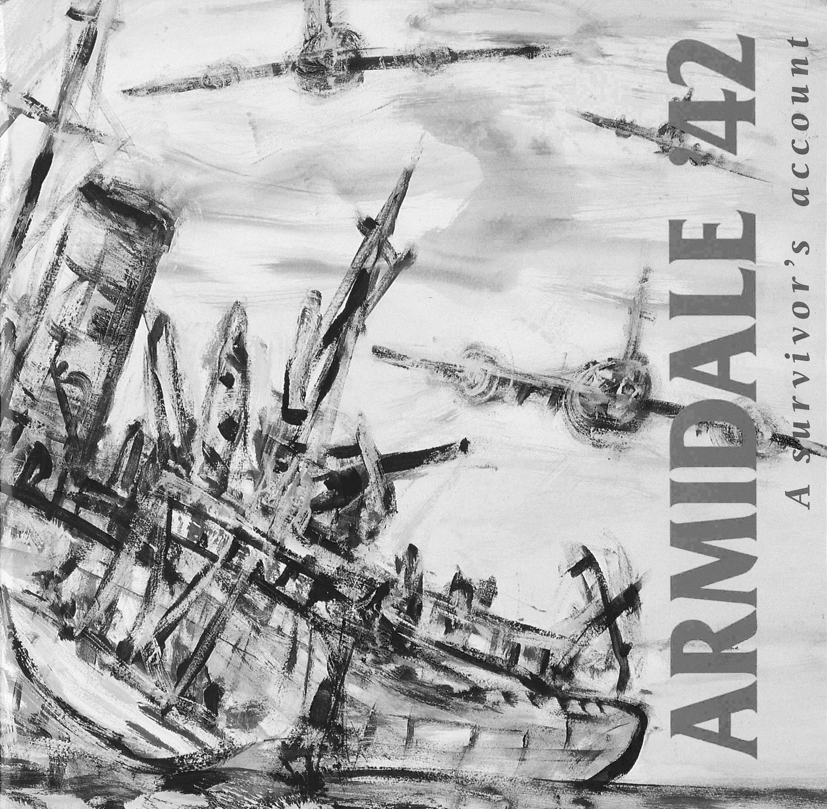Armidale ‘42:
A survivor’s account
Book review by Jerry Lattin

Col Madigan, Jan Senbergs, Don Watson. Armidale ‘42: A survivor’s account. Macmillan Art Publishing, South Yarra. 1999. 69 pp; RRP $33.00.
This book falls into no recognisable literary category, and comprises elements of formal history, personal wartime reminiscence, and theme-based graphic art. It nevertheless delivers, verbally and pictorially, a unique, vivid and personal view of the events leading up to a small Royal Australian Navy action in World War 2, the action itself, and its aftermath.
The definitive story of the sinking of HMAS Armidale near Timor in 1942 was told in Frank B Walker’s Armidale—the ship that had to die (Kingfsher Press, NSW, 1990). The Madigan/Senbergs/Watson work adds a new dimension to that conventional history, embellishing the tragedy with images that enter the soul. Drawn from a fragment of war, its essence is memory and imagination.
Armidale ‘42 opens with an essay by Don Watson which recreates the historical and strategic setting in which the drama unfolded, and describes dispassionately the events themselves. Those events are adequately covered in more detail in Brian Swan’s two-part article on the sinking of HMAS Armidale, which begins on page 19 of this issue, so will not be summarised here. Suffice to say that Watson’s essay is vivid, thought-provoking, and beautifully written—as one would expect from a master wordsmith.The essay is followed by the text of a brief address given by Col Madigan – himself an Armidale survivor – at a1998 celebration in Darwin for the 56th anniversary of Armidale’s launching. It reads almost like poetry, but his better contribution comes later.
The Armidale Drawings by Jan Senbergs (executed in pastel and acrylic wash on paper, and purchased by the Australian War Memorial) are preceded by the artist’s explanation of their genesis in an unrelated professional collaboration between himself and Madigan. The drawings themselves—11 including the frontispiece, all sparing in the use of colour—are vivid, impressionistic, stylised, filled with life and death, hope and hopelessness. They portray recognisable key events in the action and its consequences.
Notwithstanding the excellence of Watson’s introduction and the Senbergs drawings, the heart of this book lies in Col Madigan’s major contribution, titled The Armidale diary. Written mainly in the third person, the diary is a reflective ramble through a 1988 reunion in Armidale NSW. Old shipmates meet again; they share memories, recall horrors, and reminisce about lost comrades. The narrative flicks back and forth between 1942 and 1988, and few readers will encounter a more moving depiction of what it was like to be sunk by air attack and to survive in an open boat at sea for over a week. (Madigan survived in the whaler and was rescued nine days after the sinking.) Subdued criticism of the dilatory attempts to locate and rescue survivors is implied rather than expressed. As a bonus, Madigan’s story is illustrated by his own drawings, which admirably complement those of Senbergs. His lightly-limned pen-and-ink vignettes illuminate his narrative brilliantly.
Australia has a long tradition of sponsoring ‘War Artists’, including some of the nation’s finest painters. Their work stems from life on active service, often in the battle itself, and has an authenticity and immediacy that gives it historical authority. In this book, the pictorial contributions from Senbergs and Madigan extend the boundaries of that tradition: Madigan’s sketches are from memory of events that occurred decades before; and those of Senbergs go even further: his work derives from imagination, intuition and research; and from the oral and verbal depictions of others. For this reviewer, at least, it worked.
The book is tied together by a short essay by art historian Jenny Zimmer entitled Remembering and imagining. Zimmer’s piece puts into context the imaginative work of Senbergs, and links it to the contributions of the other two authors. She ties the Senbergs drawings to Théodore Géricault’s massive 1819 painting The Raft from the Medusa, drawn from a similar incident – which inspired one of Madigan’s sketches.
Armidale ‘42: A survivor’s account unashamedly appeals to the emotions. It is nevertheless a work of integrity that illustrates with word, brush and pen the consequences of war at sea against superior air power.
Col Madigan, barely out of his teens in 1942, became a successful architect. The work of Jan Senbergs is represented in the National Gallery, in all state art galleries, and several international collections. Don Watson was speech writer for Paul Keating among many other achievements.
The book’s production is high quality. Its 250mm x 240mm format may be inconvenient for some bookshelves, but was probably dictated in part by the dimensions of the Senbergs drawings. The drawings are printed separately and pasted in—a nice extra quality touch. An index is neither provided nor needed.
The publisher is Macmillan Art Publishing—so clearly the Macmillan Group regards this as an art book, not a history book. Macmillan AP assures us that the book is available on order, (ISBN 9780958574365 may be helpful for readers wishing to order) because interested buyers are unlikely to find copies on the shelves of Australian bookshops. The reason is that the main artwork (The Armidale Drawings) is lovingly stuck in by hand in small runs, only when required. Overseas, Amazon has both new and second-hand editions available in the $45 – $55 range. The rather-high second-hand price (which makes Macmillan AP’s new price look like a steal) no doubt reflects the book’s comparative rarity.
***

An excellent review and very timely based on the Sheahan VC considerations.